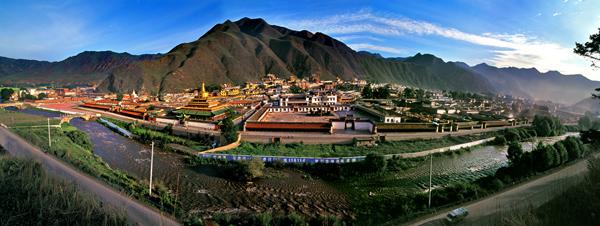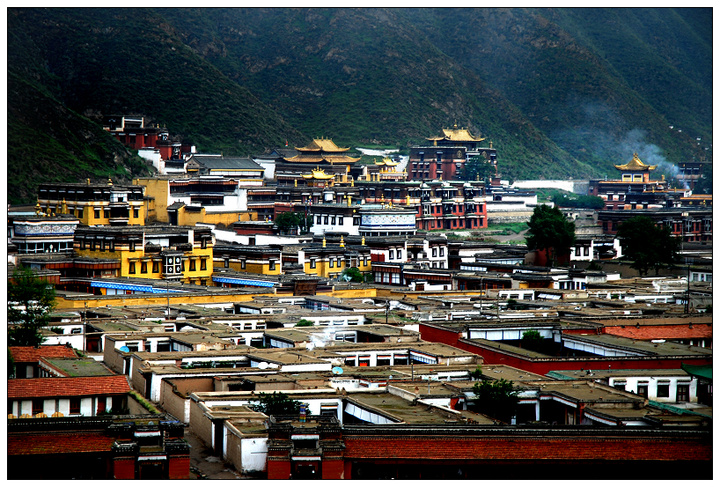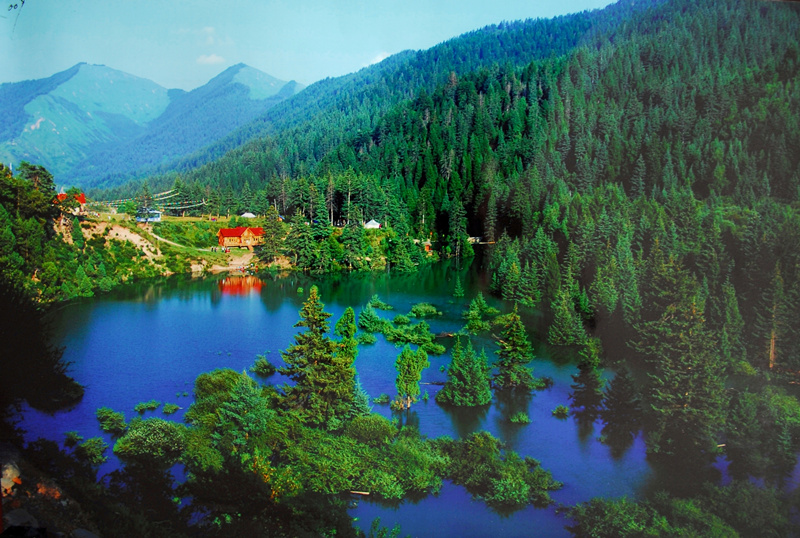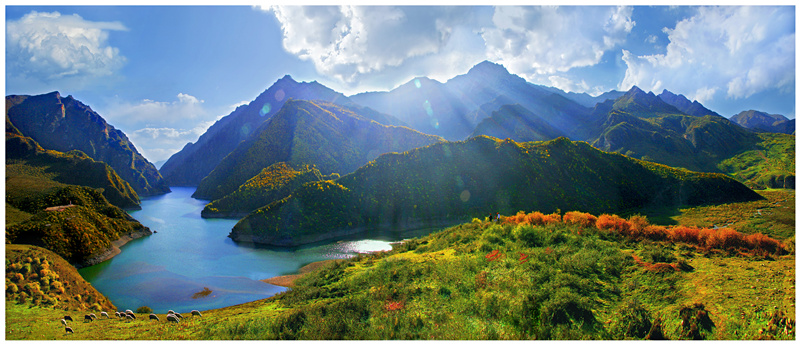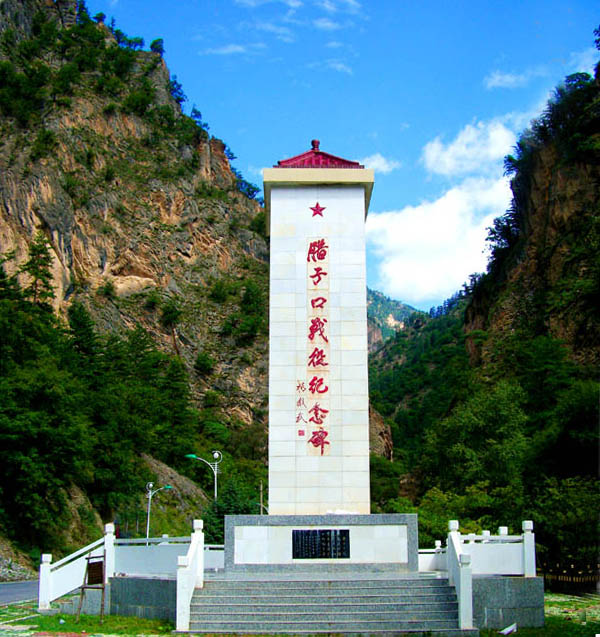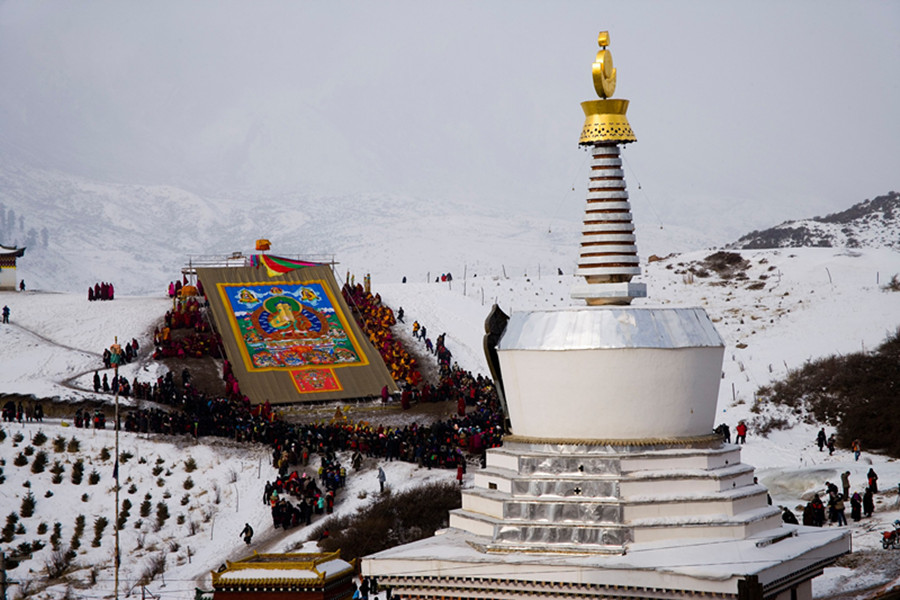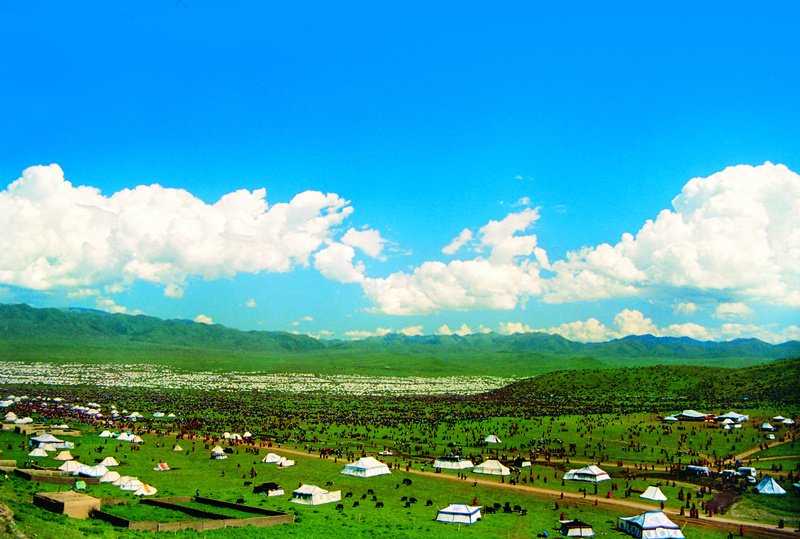Gannan Tibetan Autonomous Prefecture
As one of the 10 Tibetan autonomous prefectures in China, Gannan Tibetan Autonomous Prefecture is situated in the southwest of Gansu Province. It is in the south lane of the Silk Road and it was a junction of the Tang-Tibet Ancient Road. Gannan is where Han and Tibetan Cultures meet and exchange. The prefecture lies in the northeast fringe of the Qinghai-Tibet Plateau at the converging area with the west of Loess Plateau, 1,100 to 4,900 meters above sea level which average altitude is over 3,000 meters. The topography declines from the northwest to the southeast. It can be divided into three parts: the southern Diebu mountainous region with moderate climate, being an important forest zone in Gansu; the eastern hilly area and the eastern meadows and grassland, being the main forestry area of the province. The climate in the east of Gannan is cold and humid, for it is hilly and mountain region, framing, forest and prairie can be seen here. The west of Gannan is the major pasturing area of the province. The average temperature of the plateau area is 4 degrees Celsius; Gannan has a typical plateau climate, featuring strong sunshine, treacherous windy and rainy weather. The temperature varies greatly during the day. Gannan enjoys a long history. Early in the neolithic,Gannan was the domain of human activities; the ancient Qiang people gradually established their ally of tribes or got attached to the Central government. The major transportation means of the Tibetans here are horse and yak. Horses are considered as wings of Tibetan, and yak is known as “the boat on plateau"; both play important roles in people’s production and living. Ganna is one of major medicinal production areas in Gansu Province; there are approximately 850 various traditional Tibetan herbal medicines here and the reserves reach 52,430 tons, accounting for 62.5% of the country. Gannan is rich in natural resources; the beautiful natural landscape has caught the world’s attention, it is crowned as fairyland --- Shambhala. The prefecture enjoys picturesque scenes, Tibetan culture, special folklore customs and long history. Gnnan has the world’s biggest collection of green valleys, the Asia’s biggest natural grassland, and the most beautiful wetland in China. You can also see here one of six monasteries of the Gelug Sect of Tibetan Buddhism in China, the grand ecological garden---Yeliguan Park, colorful Dayu Valley of Zhuoni County, Sangke Prairie, Milariba Buddha Tower Block, the First Bend of Yellow River and other tourist attractions. Gannan has been rated by American travel magazines Outside and Adventure as one of the fifty “outdoor paradises for life to feel freedom" in the world, also as the 50 “must-go" places in his/her life by both Chinese National Geography and TRAVELER. UNHEP (United Nations Habitat Environment Promotion), WUCA (Worldwide United Chinese Association) acknowledged it as the “most ethnic destination in China", and the most beautiful tourist attraction in China. In recent years, with the tourism gain momentum in this Tibetan Autonomous Prefecture, Gannan opens a window for people to know about the Tibetan culture, and provides a platform for people to interact and communicate. In today’s Gannan, it is common to see tourists on the vast grassland or in the holy temples, coming from different countries, regions and places. It is no exaggerating that Gannan has already become the paradise for tourists. Xiahe Labrang Monastery (AAAA)
Labrang is the shifted sound of “Lazhang" in Tibetan language, which means the location of temple. Located in the west of Xiahe County, Gannan Tibetan Autonomous Prefecture in Gansu Province, Labrang Monastery faces the Dragon Mountain and leans against the Phoenix Mountain. With such superior geographical position, Labrang Monastery looks like a fish in the gold basin of water. The monastery was founded in 1710 by the first generation Living Buddha Jamyang Rinpoche. Having been repaired and rebuilt, it is the largest Tibetan religion and culture center in Gansu, Qinghai and Sichuan Provinces. It is honored as “World Class Institute of Tibetan Culture". Labrang Monastery has six institutes: the Institute of Esoteric Buddhism, the Institute of Medicine, Institute of Astrology and Institute of Law, Upper Tantra Institute and Lower Tantra Institute. Its Buddhism teaching system is the most complete among the monasteries in Mongolian and Tibetan regions. There are 10,000 ethnical relics and Buddhist artworks, 16 giant gilded or sandalwood Buddha over 8 meters tall in the temple halls. Also there are innumerable small and medium-sized Buddha, Bodhisattva, Pagodas and ritual instruments with various materials on display. Apart from clothing of Jamyangs’ of the past generations and other articles of daily use, the imperial edicts, seals, letters of conferring orders, inscribed boards, thousand-Buddha tree, pearl pagoda, jade ruyi (auspicious jade carving ornament), aerolite, hippocampal teeth which were presented by emperors are also enshrined in the Monastery. Large-scale summons ceremonies are held in Labrang Monastery from January 4th to 17th, and from June 29th to July 15th of Chinese lunar calendar every year. The most spectacular activities are the Sunbathing Buddha Festival and debating on Buddhist scriptures, which are held respectively in January 13th and July 8th of lunar calendar. Dayu Valley Scenic Area of Zhuoni County (AAAA)
Dayu Valley Forest Eco-tourism Area is located in Dayu Valley, Muer Village, Zhuoni County of Gansu Province, 30 kilometers away from the county. It covers an area of 105214.6 hectare. Surrounded by rippling Taohe River and the dense forest belt, Zhuoni County lies in the gorgeous scenery. Therefore, Zhuoni County is famous for the natural pageantry and Dayu Valley Scenic Area is especially attractive with the endowed magnificent landform. Brooks and springs flow freely in Dayu Valley, eventually come together into Dayuhe River, with voluminous water flow throughout the year. The winding river is crystal clear and sweet. The altitude of Zhayikega, the main peak of Dieshan Mountain in the Dayu Valley is 4920 meters and the altitude of the valley is 2500 meters. The relative height difference reaches 2400 meters. The vertical distribution of plants in the area is prominently different. Standing on the foot of Dieshan Mountain, tourists can see the bare rock lying above the snow line, then downward the alpine pasture, virgin forest, low mountain meadow, shrubs and crops. There are nine gullies in Dayu Valley: Sangbu Gully, Ajiao Small Gully, Ajiao Big Gully, Yanmai Gully, Zhayata Gully, Bashi Gully, Niezuo Gully, distributed in southeast of Dayu Valley. The nine gullies form a huge opened fan, on which a magic landscape in various colors is painted. Dayu Valley is also an original biological park with abundant resources. Major arbor and frutex species are the alpine drought-enduring coniferous fir, spruce, pine and cypress. There are 140 kinds of herbs, over 20 types of the first and second classes of animals under national-level protection in this area. All over Dayu Valley Scenic Area, rare plants and wild fruits are easily found. Yeliguan Scenic Area (AAAA)
Yeliguan Scenic Area is located in Lintan County. With Yeliguan at the center,the surrounding scenic area is divided into four parts: Lotus Mountain, West Valley, East Valley and Yehai Lake. The major scenic spots are lotus, Yemu Valley, Yehai Lake, Secluded Red Cliff Valley, and huge reclining Buddha. In Yeliguan Park, There are a famous Lotus Mountain National Nature Reserve and a National Forest Park. Walking in the park, visitors can appreciate beautiful Yemu Valley, glistening Tianchi Lake and Yehai Lake, five-kilometer long lifelike sleeping Buddha. The provincial geological park has a mountainous stone forest, mysterious Yinyangshan Rocks and Secluded Red Cliff Valley. The superior landscape centralizes perilous feature of Huashan Mountains, the elegance of Mount Emei, and gentleness of West Lake. Yeliguan Park was appraised as one of the top 50 scenic spots in the world by American tourist magazines Outside and Adventure. After the long-term development of multi-ethnic culture, Yeliguan Scenic Area has integrated the essences obtained from all sources into local customs in terms of festival, marriage, costume and cuisine. Yeliguan Scenic Area, an emerald in northwest China is a wonderful tourist attraction. Laga Mountain (AAAA)
Laga Mountain is located on the south-bank of Bailong River, in the southeast of Lijie Village, Zhouqu County of Gansu Province. Its name in Tibetan means “the favorite place of immortals". It is 12 kilometers away from No. 313 Provincial Road. The area of Laga Mountain is about 26 square kilometers. and its altitude is 1400—2800 meters. Laga Mountain has unique folk customs, gorgeous scenery with blue water and sky. It is sacred with Tibetan Buddhism in Zhouqu County. The vertical distribution of vegetation is from Subtropical Zone, Temperate Zone to Frigid Zone in the scenic region of La Gashan Mountain is distinct, and it has unique natural and human landscape which integrates Tibetan village, rivulet, grassland and forest. It is like a piece of green jade laid in the green hill and elegant valley of the south-bank of White Dragon River. Besides the beautiful natural scenery, there are unique folk customs. The Luoluo Dance, Baizhen Dance and Maling Dance all have distinctive styles. Duodi Dance, stretching and cheerful, has become “the dance of the county". On the Dragon Boat Festival in May, 2005, the “First Tourism Festival of Laga Mountain" and the Opening Ceremony of Laga Mountain Villa" were held here. Now, Laga Mountain Scenic Area has become a scenic resort for folk tourism and conference reception. Lazikou Scenic Area in Diebu County (AAA)
Diebu County is located in the southern part of Gannan Tibetan autonomous prefecture, featuring the forest ecological environment with colorfully local ethnic customs. Its cultural and natural landscape is the epitome of Qinghai-Tibet Plateau. Diebu was one of the key stops that the Chinese Workers’ and Peasants’ Red Army passed by during the 12,500-kilometer Long March. Located in the northeast of Diebu County, Lazikou is the natural barrier, defending the southern part of Gansu Province. It also was the last strategic pass that was captured by the Central Red Army in Long March. It is well known for the famous Lazikou Battle. The word “Lazi" is the transliteration of lezur in Tibetan language, meaning “near the mountain pass" or “at the foot of a mountain". The total area of La Zikou is 444 square kilometers. Lazikou is a mountain pass in Minshan Mountains with towering cliffs on both sides and fast-flowing Lazi River in the middle. The terrain of the scenic spot declines from the northwest to the southeast part, and its average altitude is 2900 meters. There are some very elegant and pretty natural wonders made up of mountains, water, lakes and waterfalls. The wonders are distributed in Niulu Ravine, Meilu Ravine, Laolong Ravine, Longzhua Ravine, Jiulicai Ravine, Zhuli Ravine and some other Ravines. The climate of the ravines of Lazikou Scenic Area belongs to semi-humid zone with moderate rainfall, also under the combined impact of warm temperate zone and tierra. There is no chilly winter or hot summer. It is the ideal resort for leisure vacation, adventure and the red tourism. Langmu Monastery
Langmu Monastery, a Tibetan Buddhist temple, is located in Langmusi Township, 90 kilometers south of Luqu County. It is beside Bailong River at the hill foot of the north side of Guoer Mangliang Mountain, a branch of Xiqing Mountains. Langmu Monastery covers common boundary of Gansu, Qinghai, Sichuan provinces. “Langmu" in Tibetan language is Lady Fairy, and the name derives a lady-like stone in the nearby cave. The stone was incarnated by a fairy, as a popular legend says. At the back of the monastery, there is a tiger’s cave hiding behind the thick woods, and the cave has a Tibetan name – Dehecang. Therefore, the name of the monastery can be interpreted as Lady Fairy in Tiger’s Cave. Across Bailong River, Nagel is in Sichuan side beyond the borderline, once in history reached its peak time. In front of Langmu Monastery is a monk-hat shape mountain. On the east side of the monastery stands a cliff of red sandstone and conglomerate. On the west side are tall and rugged peaks, large patches of pines carpeting the foot of the mountains. Sangke Prairie
Sangke Prairie is located in Xiahe County, Gannan Tibetan Autonomous Prefecture, Gansu Province, which lies about 10 kilometers southwest of Labrang, Xiahe County, and there is highway through. Belonging to the meadow steppe, Sangke Prairie is a part of Dajiu Grassland (or Running Horse Grassland) Prairie. It is an alpine steppe with flat and open land in the middle and is surrounded by hills. Sangke Prairie is at an average elevation of 3,000 meters with an area of 70 square kilometers. It is the place where legendary King Gesar held memorial ceremony for gods. It also is one of the main bases of animal husbandry in Gannan Tibetan Autonomous Prefecture. Daxia River flows slowly through Sangke Prairie from south to north. There are lush water plants and elegant scenery. Under the blue sky and white clouds, there are countless sheep and yaks. All of these present the idyllic scenery, and it is always the natural pasture of Tibetan people. With the rise of tourism, Sangke Prairie has become sightseeing’s hot spot for domestic and foreign tourists. Since 1987, Sangke Prairie has opened the tourism project having strong Tibetan flavor. Tents have been built for tourists’ accommodation. Tousits can taste Tibetan food here, such as milky tea, Zanba (a traditional Tibetan staple food of roasted highland barley flour), stuffed steamed buns and Shouzhua mutton (mutton eaten with hands). Visitors also can appreciate the Tibetan folk culture to the full by wearing Tibetan costumes and riding horses or yaks across the grassland. Milariba Buddha Pavilion
Milariba Buddha Pavilion, with the full name “Amdo Hezuo Milariba Nine-Storey Buddha Pavilion", is located in Hezuo city Amdo Tibetan-inhabited areas Gansu Province. It was first built in 1777, the forty second year of Qianlong in the Qing Dynasty. The original building was destroyed and the existing one was rebuilt in May in 1988, which took 4 years to complete. The pavilion was built in memory of the eminent monk Milariba. It is the most important temple in Amdo Tibetan area of Gelu sect in Tibetan Buddhism. Milariba, the legendary and well-known eminent monk, is worshipped in the Buddha Pavilion. The nine-storey building also enshrines his disciples who were the founders of different sects in Tibetan Buddhism. There are 1,720 figures of the Buddha, Bodhisattva and the protective deities. Large size murals represent the multiple themes of Tibetan Buddhism. The painting skills are superb skills and of highly artistic value. There are two Milariba Buddha Pavilions in Tibetan regions of China. This magnificent Buddha Pavilion is one of the famous Tibetan Buddhism temples. The residential lamas in the temple study Buddhism and worship Buddha all the year round, cultivating a unique cultural atmosphere. The theme of each storey of Buddha Pavilion varies: the first storey mainly worships the Buddhas of Tibetan Buddhism, such as Byams-pa (Maitreya of Han Buddhism), Sakyamuni, Manjusri, Guanyin, Vajrapani, Pharmacists, Tara, Usnisa-sitatapatra and so on. The second storey worships Tsongkhapa, the founder of Shaman, and his disciples. The third storey enshrines the mentor of Nyingma (Mongolian Lamaism), which is the oldest Buddhist sect. They are Padmasambhava, Shivacuo and Chisong Dêzain. Each storey represents a historical stage or a sect of Tibetan Buddhism, including the names of celebrities in Tibetan history, like Thonmi Sambhota, father of Tibetan language; Tongdong Gyibo, founder of Tibetan Opera; Yu yuan Dan kampot, the father of Tibetan medicine. And of course, Sontzen Gampo and Princess Wencheng should be included. |
Gannan Tibetan Autonomous Prefecture
December 21, 2016
VIEWED: 0
